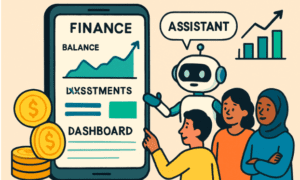The saying “The Future Is Now” couldn’t be more appropriate in the constantly changing world of finance. Our approach to money management is undergoing a revolution, and the idea of digital banking is at the forefront of this change. We’ll discuss the fundamentals of digital banking today and how it’s changing the financial environment.
Imagine living in a society where you can check your bank account, carry out transactions, and even apply for loans all online. Digital banking is the term for that world right now. But what is digital banking really, and why is it catching on so quickly?
Briefly put, digital banking is the practice of providing financial services online or through mobile apps. It includes a broad range of monetary actions, including everything from monitoring your account balance to making investments. Convenience is crucial in this situation, and in our hectic lives, that’s a game-changer.
Accessibility is one of the main benefits of digital banking. You don’t need to stand in huge lines or rush to the bank during your lunch hour. You may complete purchases, make payments for bills, and even set up automatic savings programs with just a few clicks on your smartphone. For individuals with hectic schedules, its accessibility is a gift from heaven.
Digital banking offers a variety of advantages that were previously only available to high-net-worth individuals, so it’s not just about ease. Consider the ability to make stock market investments. Investing was once thought of as a difficult and complicated procedure. Nowadays, you may start investing with as little as a few dollars thanks to digital banking services. The financial industry is rapidly becoming more democratic.
Digital banking’s emphasis on data-driven decision-making is another noteworthy feature. Digital banks examine your spending habits, income, and financial goals to provide personalized suggestions. Traditional banks may have depended on paperwork and in-person meetings to evaluate your financial health. It’s similar to carrying a financial adviser around with you.
Furthermore, digital banks place a high focus on security. Strong safety for your financial information is provided by cutting-edge encryption methods and multi-factor authentication. These security measures are necessary for a sense of security given the increase in cyberthreats.
Financial inclusion is also greatly aided by digital banking. Due to geographical limitations, people lacked access to fundamental financial services in many parts of the world. People in remote locations can now benefit from digital banking with just a smartphone and an internet connection. This not only gives them more power but also encourages economic development in neglected neighborhoods.
It’s critical to realize that this is not a one-size-fits-all situation as we delve farther into the digital financial ecosystem. Traditional banks are still useful, and many individuals value their physical presence and in-person interactions. However, the goal of digital banking is to enhance traditional banking, not to replace it.
A hybrid banking system that combines traditional and digital banking is where the future of finance resides. In order to meet the evolving needs of their consumers, banks are progressively incorporating digital solutions into their services. People can select the banking experience that best suits them thanks to this blending of the old and the new.
How then can you successfully traverse this financial digital landscape? Here are some pointers:
- Educate Yourself: Spend some time learning about the capabilities and services provided by various digital banking platforms. Find one that complements your interests and financial objectives.
- Secure Your Accounts: Although digital banking is safe, it’s still important to adhere to safe online behavior guidelines. Enable two-factor authentication, use strong, unique passwords, and be wary of phishing scams.
- Keep Up: Keep abreast of the most recent advancements in financial and digital technology. Being informed can help you take advantage of the new features and services that are always being launched.
- Consult a Financial Advisor: If you’re new to digital banking or have complex financial needs, you might want to consider doing so. They can aid in the optimization of your financial plan and the making of educated judgments.
Digital banking is setting the pace for the financial industry’s future. Digital banking is revolutionizing the way we handle our money because to its ease of use, accessibility, and wealth of options. But it’s important to keep in mind that the goal is to improve traditional banking, not to replace it. As a result, if you embrace the digital revolution correctly, the financial future will be even more promising.



































